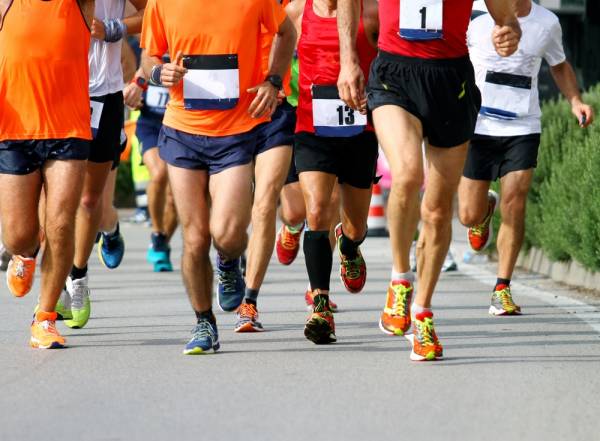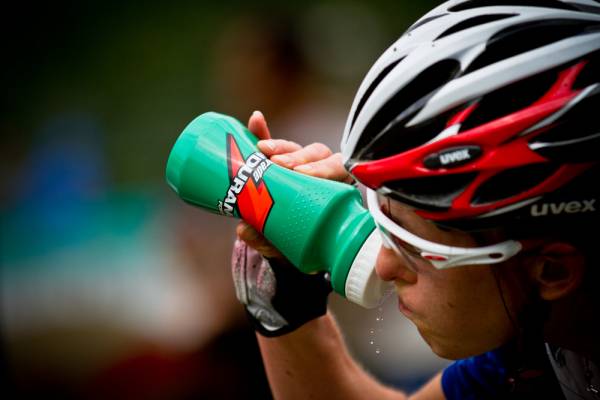Moving with good form requires the right kind of fuel. Simply look at triathletes finishing an Ironman or runners finishing a marathon. Often they are bent over, twisted, and shuffling. Their gait patterns have been broken. Their bodies have been broken.
Moving with good form requires the right kind of fuel. Simply look at triathletes finishing an Ironman or runners finishing a marathon. Often they are bent over, twisted, and shuffling. Their gait patterns have been broken. Their bodies have been broken.
You’d be surprised at how rapidly your gait falls apart when your gas tank is low.You may start out your run with fluid motion and with swift and efficient form. Yet after twenty or thirty minutes – or maybe at mile twenty, for you marathoners – you may look as though you ran through a minefield, dragging one leg, swinging one arm out to the other side, scuffing your heels, and drooping your head.And at the finish line, you look even worse as you’re leaning to one side or hunched over because your lower back is in agony.
Did an injury occur during your run? In a way, yes, but not so directly.
Consequences of Muscle Imbalance
When your body is stressed due to dehydration, glycogen depletion, and other nutrient imbalances, the muscles no longer have the correct fuel to keep them functioning at their best, so they fatigue. The glucose or fluid isn’t there to keep the muscles firing properly or maybe electrolytes are so depleted the muscles can’t contract as well as they should.
Hydration is much more than just taking in water. Your body has to absorb the water to use it. Fatigued adrenal glands from too much physical, nutritional, or emotional stress cause the body to lose excess sodium so it cannot hold onto the water. This makes sense to the person who drinks and drinks and drinks, but always feels thirsty or urinates often.
“Muscle imbalances result in gait imbalances. Gait imbalances essentially create biomechanical problems – stability, balance, and movement problems.
Athletes in this state are not only dehydrated, but their gait (and therefore exercise performance) is suffering. Any endurance athlete is familiar with white salt lines or caking on their cycling or running shorts. It’s a sign of too much sodium loss. These hydration issues and electrolyte imbalances result in muscle imbalances.
The muscle imbalances then result in gait imbalances. The gait imbalances essentially create biomechanical problems – stability, balance, and movement problems. Next thing you know, you’re injured (if not immediately, then soon enough).

The Insulin-Gait Link
Improper carbohydrate metabolism is another big factor that can affect gait. Insulin resistance occurs when a person is making too much insulin because their body is no longer responding to the current hormone level needed to get the job done. It often occurs from consuming too many refined sugars and flours, but can also be from too many carbohydrates in general.
The pancreas must manufacture more and more insulin to process the same amount of glucose that it once only used a little amount to handle. Over time, the pancreas becomes less efficient in metabolizing the carbohydrates, so too much insulin is produced and the person winds up with signs and symptoms of blood-sugar handling problems. These include irritability, cravings for sweets, excessive appetite, afternoon drowsiness or headaches, getting the shakes, and trouble sleeping, just to mention a few.
“Many people who go off their high-carbohydrate diet resolve most of their aches and pains for this reason. Adjusting your diet away from bagel-and-sugary-coffee breakfasts most likely will result in dramatic changes in your health and performance.”
These people also have irregular gait patterns, which explain why most, if not all of these individuals, have some chronic ache, pain, or injury. Essentially, insulin levels affect how you move.
This insulin-gait link is a relatively new concept to most. If it’s too radical a concept for some (perhaps you), then look at it from a strictly neurological perspective. High levels of insulin affect the brain directly – not just mental function, but also physical function. Of course, a healthy, functioning brain is needed to move, so the more the brain is lacking proper nutrition, then the more it will be impaired, and therefore gait will suffer.

Many people who go off their high-carbohydrate diet resolve most of their aches and pains for this reason. Adjusting your diet away from bagel-and-sugary-coffee breakfasts most likely will result in dramatic changes in your health and performance.
The double-edged sword is seen when you add the fact that under high-stress situations, such as overtraining, the body makes too much cortisol, which in turn raises insulin levels, at least in the short term. So not only does the burden of high insulin levels need to be dealt with, but chronic hormonal stress will lead to weakened ligaments (that’s what high cortisol levels do), muscle breakdown, and inflammation.
When to Eat to Move Your Best
Gait is affected by insulin levels so much that it is important to not only know what to eat or drink, but also when to do so. One major mistake many endurance athletes make is that they drink a carbohydrate solution right up until the start of a race.
“Gait is affected by insulin levels so much that it is important to not only know what to eat or drink, but also when to do so.”
I have seen people at the start of a half marathon or Ironman race packing in the fluid replacement drinks or, even worse, consuming a gel pack. They have quickly increased their blood sugar and insulin levels and begun the sugar-burning process despite the fact the race will demand the majority of energy come from the body’s plentiful fat stores, as in any aerobic activity. An improper gait usually follows, and natural movement is now lost.
The proper thing to do is stop all carbohydrate consumption one hour prior to your event. Then, do not consume any carbohydrates until at least fifteen to thirty minutes into the race. After fifteen minutes, thebody’s cells will respond to glucose without the insulin surge from the carbohydrate consumption. At the end of the event,especially those lasting well over one hour, try to consume the majority of your carbohydrates within sixty minutes, as well as some protein.

Eat Well to Move Well
Remember, muscle imbalances can come from everything and anything – and most often are a result of too much stress (including excess training) and a poor diet. Consuming too much refined sugar or inflammatory-type fats, such as refined vegetable oils or hydrogenated fats, will result in muscle imbalances and therefore trigger points (in essence, an injury).
“Remember, muscle imbalances can come from everything and anything – and most often are a result of too much stress (including excess training) and a poor diet.”
Training too hard (many high-intensity workouts) or getting inadequate recovery (or poor sleep) will also cause various muscle imbalances. These most commonly occur in the knee, lower leg, ankle, and foot and result in injuries and trigger points. Yes, the trigger points need to be addressed, but it is as important, if not more, to address why they’re there. These are concepts traditional medicine does not recognize or understand.
The reality is, many people, including “fit athletes” eat poorly, are under substantial stress, and train improperly. So, what happens? Well, they get injured. The injury is a result of biomechanical imbalances that affect natural movement. To avoid this vicious cycle, adhere to a proper diet and, in turn, your body will move much more efficiently.
You Might Also Enjoy:
- How to Use Manual Therapy to Restore Essential Gait Mechanics
- How to Move Better and Relieve Pain
- Shred-telligent Design: How to Ramp Up Your Major Lifts
- What’s New on Pulse Beat Fit UK Today
Photos courtesy of Shutterstock.






